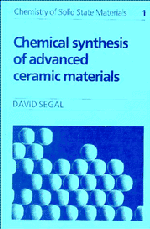Book contents
- Frontmatter
- Contents
- Preface
- Symbols
- 1 Introduction: the variety of ceramic systems
- 2 Conventional routes to ceramics
- 3 Ceramic fabrication
- 4 Sol–gel processing of colloids
- 5 Sol–gel processing of metal–organic compounds
- 6 Non-aqueous liquid-phase reactions
- 7 Polymer Pyrolysis
- 8 Hydrothermal synthesis of ceramic powders
- 9 Gas-phase reactions
- 10 Miscellaneous synthetic routes to ceramic materials
- Appendix: Determination of particle size
- References
- Index
5 - Sol–gel processing of metal–organic compounds
Published online by Cambridge University Press: 04 April 2011
- Frontmatter
- Contents
- Preface
- Symbols
- 1 Introduction: the variety of ceramic systems
- 2 Conventional routes to ceramics
- 3 Ceramic fabrication
- 4 Sol–gel processing of colloids
- 5 Sol–gel processing of metal–organic compounds
- 6 Non-aqueous liquid-phase reactions
- 7 Polymer Pyrolysis
- 8 Hydrothermal synthesis of ceramic powders
- 9 Gas-phase reactions
- 10 Miscellaneous synthetic routes to ceramic materials
- Appendix: Determination of particle size
- References
- Index
Summary
Introduction
Sol–gel processing of colloids described in chapter 4 allows the preparation of homogeneous compositions and crystalline phases at temperatures lower than required for conventional powder mixing. However, sol particles contain between 103 and 109 molecules and improved mixing of components can occur by interaction at the molecular rather than colloidal level. This is achieved during the hydrolysis of metal–organic compounds, namely alkoxides. Sol–gel processing of alkoxides has attracted intense interest in the past 15 years because it offers non-melt routes to high-purity glasses and crystalline ceramics. The synthesis and hydrolytic reactions of alkoxides are described in this chapter, together with their use in the preparation of a wide range of ceramic materials.
The synthesis of metal alkoxides
Metal alkoxides have the general formula M(OR)Z and can be considered to be derivatives of either an alcohol, ROH where R is an alkyl chain, in which the hydroxyl proton is replaced by a metal M, or of a metal hydroxide, M(OH)Z.
Ebelman (1846) made the first synthesis of an alkoxide, silicon tetraisoamyloxide, by reacting silicon tetrachloride with isoamyl alcohol. This was followed (Ebelman & Bouquet, 1846) by the preparation of boron methoxide, ethoxide and amyloxide using boron trichloride and the corresponding alcohol. Electronegativity of the main element is an important factor in the choice of synthetic route so that strongly electropositve metals with valencies up to three react directly with alcohols to give alkoxides together with the liberation of hydrogen.
- Type
- Chapter
- Information
- Chemical Synthesis of Advanced Ceramic Materials , pp. 58 - 88Publisher: Cambridge University PressPrint publication year: 1989
- 2
- Cited by

